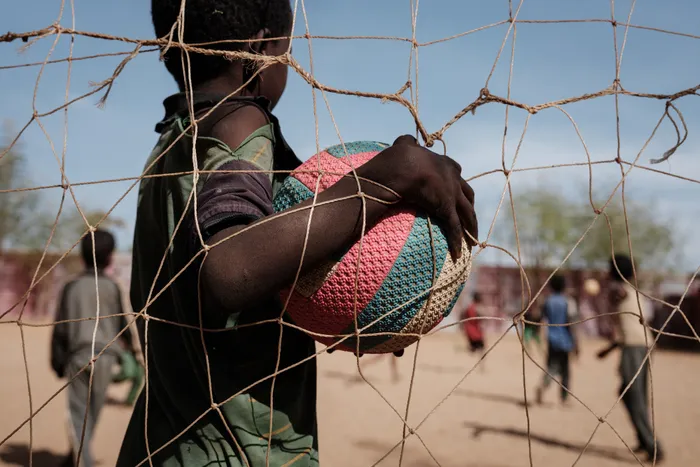‘Silent learning’ crisis requires urgent action

Picture: Yasuyoshi Chiba/AFP - Children play on a playground installed by the NGO Save The Children at Garas Goof camp, one of the 500 camps for internally displaced persons in Baidoa, Somalia. Milions of children in Sub-Saharan Africa are being denied schooling owing to continuing conflict, poverty and cycles of devastating drought, say the writer.
By Abhiyan Jung Rana
Abduwali is 13 years old, but has never spent a day in a classroom. He grew up in a rural area of central Somalia, where ongoing conflict, poverty and cycles of devastating drought made it impossible for his family to send him to school.
The latest drought – the worst in 40 years – has compounded the situation. Starved of food and water, he and his family were forced to join the more than one million people who fled their homes in the country, walking for more than two days to seek emergency support in the town of Baidoa.
Abduwali is at the epicentre of a global learning crisis. Sub-Saharan Africa has the highest number of children and youth out of education in the world – with 98 million denied the chance to go to school; 41 million of these children live in Eastern and Southern Africa. Sub-Saharan Africa also has the lowest rates of reading comprehension in the world: only one out of 10 ten-year-olds can read and understand a simple text. Human, health and climate-fuelled emergencies are huge contributory factors.
Due to climate change, countries like Mozambique and Malawi have seen a rise in the frequency and severity of climate-related disasters like floods and cyclones.
Meanwhile, the Horn of Africa is enduring one of the worst droughts in living memory. Fifteen million children are already out of school across Ethiopia, Kenya and Somalia, with more than 3.6 million more at risk of dropping out because of the crisis.
Health emergencies – including Ebola and cholera - also wreak a terrible toll. Covid-19 is another notable example. In Eastern and Southern Africa, 164 million children were kept out of learning due to long school closures of up to two years in some countries. The poorest, most marginalised children suffered the most: girls, children with disabilities and those living in countries affected by conflict or disasters.
Some children returned to classrooms having forgotten to read and write entirely. Children who were already facing under-resourced schools, underpaid and under-qualified teachers, over-crowded classrooms and archaic curricula lost approximately 150 billion hours of in-person learning.
When children are out of school, they don’t just miss out on education: their exposure to physical, emotional and sexual violence increases. During the pandemic, child marriages rose in some countries, while West Africa’s experience of Ebola demonstrates how child exploitation, abuse and teen pregnancies spike when schooling stops.
Nutrition is also a key partner of education in many parts of Sub-Saharan Africa. If children do not come to school, they cannot access feeding programmes, which in most cases, comprise the only nutritious food the children get. The economic consequences for communities are enormous. Lost schooling from Covid-19 alone could lead to half a trillion US dollars lost in future earnings in Sub-Saharan Africa.
This silent crisis requires urgent and widespread action across the region. Not only do children need to be in school, they also must be learning effectively when they are there. Unicef is working with governments in Eastern and Southern Africa to support children to catch up on learning, using proven methods such as structured lesson plans and ensuring children are taught at the level they need. This is supported through investing in teacher training, curriculum reform, digital learning and early childhood education. We need governments and donors to do much more though.
For their part, governments need to allocate at least 20% of their national budgets to education, ensuring it is allocated equitably, effectively and efficiently. The average budget allocation in Eastern and Southern Africa is 16%, but this masks the fact that there are some countries that allocate less than 3%.
Funding for life-saving education in humanitarian emergencies also needs to be prioritised and not delegated to a second phase of response. Funding is similarly needed to improve the resilience of education systems. For example, by working with Ministries of Education, schools, communities and children to help prepare for and better respond to future disasters.
Moving forward, our primary focus needs to be on building children’s foundational literacy and numeracy: assessing them on their knowledge of these key skills and providing them with any catch-up support as needed, as well as ensuring they stay in school. Young people’s employability must also be improved by providing them with market-relevant skills and ensuring classrooms embrace the digital revolution.
Back in Baidoa, Somalia, Abduwali has managed to access education for the very first time at an emergency Unicef-supported school in a camp for displaced people. At 13, he is in Grade 1: a class that is full of children who have never entered a classroom before. He is learning the alphabet and mathematics. He hopes to catch up on the years he has lost and to stay in education. Millions of children across the region deserve the same chance. We must act quickly. Otherwise, the long-term effects on children’s lives and development, as well as their countries’ economies, will be truly catastrophic.
Abhiyan Jung Rana is Unicef Regional Education Advisor, Eastern and Southern Africa.